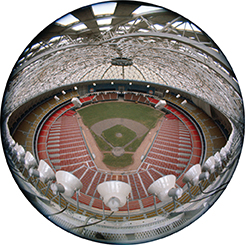Discovery of the Nucleus
The alpha particles whose paths were deflected must have come close to another charged object. The closer they came, the greater the deflection was. But many alpha particles passed through the gold without being deflected. From these results, Rutherford concluded that the positive charge of an atom is not evenly spread throughout the atom. It is concentrated in a very small, central area that Rutherford called the nucleus. The nucleus is a dense, positively charged mass located in the center of the atom. (The plural of nucleus is nuclei.)
Figure 8 The Houston Astrodome occupies more than nine acres and seats 60,000 people. If the stadium were a model for an atom, a marble could represent its nucleus.
Using Analogies In the model, where would the marble have to be located in the stadium to represent the nucleus?

Because Thomson's model no longer explained all the evidence, Rutherford proposed a new model.  According to Rutherford's model, all of an atom's positive charge is concentrated in its nucleus. The alpha particles whose paths were deflected by more than 90 degrees came very close to a nucleus. The alpha particles whose paths were not bent moved through the space surrounding the nuclei without coming very close to any nucleus.
According to Rutherford's model, all of an atom's positive charge is concentrated in its nucleus. The alpha particles whose paths were deflected by more than 90 degrees came very close to a nucleus. The alpha particles whose paths were not bent moved through the space surrounding the nuclei without coming very close to any nucleus.
Figure 8 shows the inside of the Astrodome, a domed stadium in Houston, Texas. The roof of the stadium rises to a height of 202 feet above the center of the field. If an atom had the same volume as the stadium, its nucleus would have the volume of a marble. The total volume of an atom is about a trillion (1012) times the volume of its nucleus.
Section 4.1 Assessment
Reviewing Concepts
 What theory did Dalton propose about the structure of matter?
What theory did Dalton propose about the structure of matter? What evidence did J. J. Thomson provide about the structure of an atom?
What evidence did J. J. Thomson provide about the structure of an atom? What did Rutherford discover about the structure of an atom?
What did Rutherford discover about the structure of an atom?What evidence did Thomson have that his glowing beam contained negative particles?
Why was Dalton's model of the atom changed after Thomson's experiment?
Critical Thinking
Comparing and Contrasting Explain why scientists accepted Dalton's atomic theory but not the idea of an atom proposed by the Greek philosophers.
Drawing Conclusions If you observed a beam of particles being bent toward a negatively charged plate, what might you conclude?
Relating Cause and Effect In the Rutherford experiment, why weren't all the alpha particles deflected?
Writing in Science
Writing to Persuade Imagine you live in ancient Greece. Assume all you know about matter is what you can observe with your five senses. You have heard the views of both Democritus and Aristotle about matter. Write a paragraph supporting one of their views.




